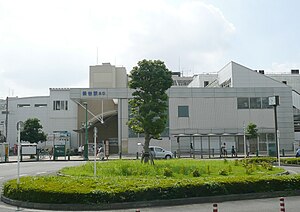Hōya Station
Hōya Station 保谷駅 | |||||
|---|---|---|---|---|---|
 North entrance of Hōya Station, September 2011 | |||||
| General information | |||||
| Location | 3-14-30 Higashichō, Nishitōkyō-shi, Tokyo (東京都西東京市東町3-14-30) Japan | ||||
| Operated by | |||||
| Line(s) | |||||
| Platforms | 1 side and 1 island platform | ||||
| Other information | |||||
| Station code | SI12 | ||||
| History | |||||
| Opened | 1915 | ||||
| Passengers | |||||
| FY2015 | 60,058 daily | ||||
| |||||
Hōya Station (保谷駅, Hōya-eki) is a railway station in Nishitōkyō, Tokyo, Japan, operated by the private railway operator Seibu Railway.
Lines
Hōya Station is served by the Seibu Ikebukuro Line from Ikebukuro in Tokyo, with some services inter-running via the Tokyo Metro Yurakucho Line to Shin-Kiba and the Tokyo Metro Fukutoshin Line to Shibuya and onward via the Tokyu Toyoko Line and Minato Mirai Line to Motomachi-Chukagai. Located between Ōizumi-gakuen and Tokyo, it is 14.1 km from the Ikebukuro terminus.[1]
Station layout

The station has one island platform and one side platform serving a total of three tracks. The side platform serves trains going up on track 3. The island platform serves trains going down on platform 1 and some trains either go up or down on platform 2.[2]
A siding exists between the running tracks west of the station for use by trains terminating at Hōya.[2] Stabling tracks also exist north of the line to the west of the station.[2]
Platforms
| 1 | ■ Seibu Ikebukuro Line | for Tokorozawa and Hannō |
| 2 | ■ Seibu Ikebukuro Line | for Tokorozawa and Hannō |
| ■ Seibu Ikebukuro Line | for Nerima and Ikebukuro Tokyu Toyoko Line for Yokohama Minatomirai Line for Motomachi-Chukagai | |
| 3 | ■ Seibu Ikebukuro Line | for Nerima and Ikebukuro Tokyu Toyoko Line for Yokohama Minatomirai Line for Motomachi-Chukagai |
Adjacent stations
| ← | Service | → | ||
|---|---|---|---|---|
| Seibu Ikebukuro Line | ||||
| Limited express: Does not stop at this station | ||||
| Rapid express: Does not stop at this station | ||||
| Express: Does not stop at this station | ||||
| Rapid: Does not stop at this station | ||||
| Ōizumi-gakuen | Commuter express | Higashi-Kurume | ||
| Ōizumi-gakuen | Commuter semi express | Tokyo | ||
| Ōizumi-gakuen | Semi express | Hibarigaoka | ||
| Ōizumi-gakuen | Local | Hibarigaoka | ||
History

The station opened on April 15, 1915.[1]
The new station building opened on December 27, 1991.[citation needed] The north entrance was rebuilt in 2003.[citation needed]
Station numbering was introduced on all Seibu Railway lines during fiscal 2012, with Hōya Station becoming "SI12".[3]
Through-running to and from Yokohama and Motomachi-Chukagai via the Tokyu Toyoko Line and Minatomirai Line commenced on 16 March 2013.[4]
Passenger statistics
In fiscal 2015, the station was the 14th busiest on the Seibu network with an average of 60,058 passengers daily.[5]
The passenger figures for previous years are as shown below.
| Fiscal year | Daily average |
|---|---|
| 2000 | 52,643[1] |
| 2009 | 56,041[6] |
| 2010 | 55,545[7] |
| 2011 | 55,162[8] |
| 2012 | 56,684[9] |
| 2013 | 58,280[9] |
References
- ^ a b c Terada, Hirokazu (July 2002). データブック日本の私鉄. Japan: Neko Publishing. p. 201. ISBN 4-87366-874-3.
{{cite book}}: Unknown parameter|trans_title=ignored (|trans-title=suggested) (help) - ^ a b c Kawashima, Ryozo (March 2011). 日本の鉄道 中部ライン 全線・全駅・全配線 第12巻 東京都心北部. Japan: Kodansha. p. 33/65. ISBN 978-4-06-270072-6.
{{cite book}}: Unknown parameter|trans_title=ignored (|trans-title=suggested) (help) - ^ 西武線全駅で駅ナンバリングを導入します (pdf). News Release (in Japanese). Japan: Seibu Railway. 23 February 2012. Retrieved 10 February 2013.
{{cite web}}: Unknown parameter|trans_title=ignored (|trans-title=suggested) (help) - ^ 東急東横線・メトロ副都心線相互直通、16日スタート. Nikkei.com (in Japanese). Japan: Nikkei Inc. 15 March 2013. Retrieved 2 April 2013.
{{cite web}}: Unknown parameter|trans_title=ignored (|trans-title=suggested) (help) - ^ 駅別乗降人員 2015(平成27)年度 1日平均 (PDF) (in Japanese). Japan: Seibu Railway. Retrieved 7 June 2015.
{{cite web}}: Unknown parameter|trans_title=ignored (|trans-title=suggested) (help) - ^ 駅別乗降人員 2010(平成22)年度 1日平均 (PDF) (in Japanese). Japan: Seibu Railway. Retrieved 26 January 2013.
{{cite web}}: Unknown parameter|trans_title=ignored (|trans-title=suggested) (help) - ^ 各駅の乗車人員 (2010年度) (in Japanese). Japan: East Japan Railway Company. Retrieved 26 January 2013.
{{cite web}}: Unknown parameter|trans_title=ignored (|trans-title=suggested) (help) - ^ 駅別乗降人員 2011(平成23)年度 1日平均 (PDF) (in Japanese). Japan: Seibu Railway. Retrieved 26 January 2013.
{{cite web}}: Unknown parameter|trans_title=ignored (|trans-title=suggested) (help) - ^ a b 駅別乗降人員 2013(平成25)年度 1日平均 (PDF) (in Japanese). Japan: Seibu Railway. Retrieved 22 June 2014.
{{cite web}}: Unknown parameter|trans_title=ignored (|trans-title=suggested) (help)
External links
- Hōya Station information (Seibu Railway) Template:Ja icon

